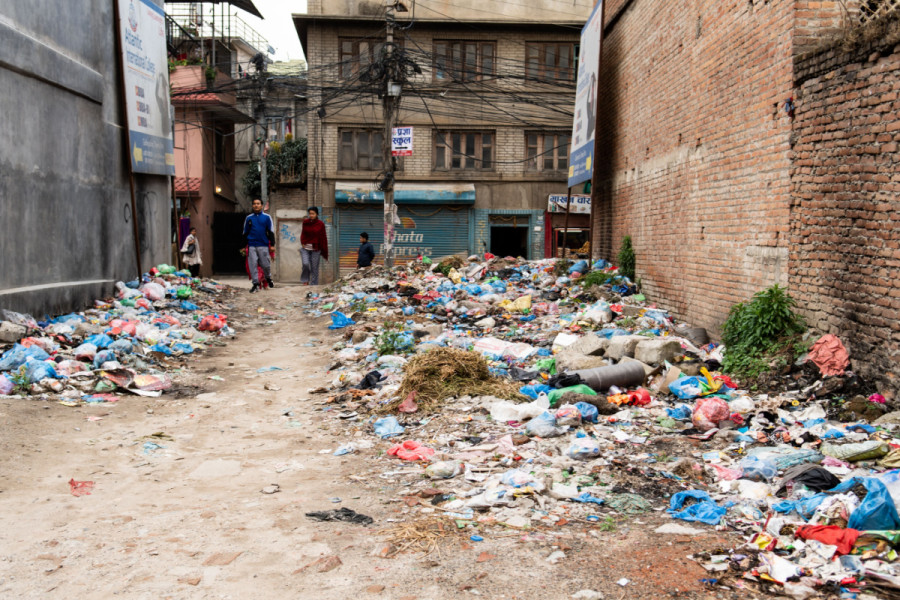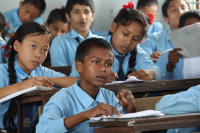Columns
Reducing plastic waste
We should control plastic pollution before the environmental damages become irreversible.
Anustha Shrestha
The discovery of microplastics near the peak of Mount Everest made major news portals in 2020. A team of interdisciplinary scientists found the presence of microplastics in the snow and stream water samples. These microplastics were mostly polyester fibres used in clothing, ropes and tents. Though single-use plastics are banned in the Everest region, microplastics are serious issues of concern since they are difficult to remove from the environment. Scientists have concluded that plastics of all sizes are ubiquitous and have reached the depths of oceans and the tops of mountains.
Challenges and impacts
The global plastics production (estimated by Statista) for 2021 was 390.7 million metric tons, with an annual increase of 4 percent. Similarly, the International Centre for Integrated Mountain Development (ICIMOD) reported in 2018 that plastic comprised 16 percent of Nepal’s urban waste, with a daily generation of 2.7 tons. Plastic production soared after World War II and revolutionised technologies, upgrading medical devices, drinking water equipment and transport technologies. Despite making our lives more convenient, the mass production and subsequent disposal of plastics have paved the way for a “throw-away culture”.
As mentioned in a 2019 National Geographic article, single-use plastic accounts for 40 percent of plastics produced every year. Plastics do not decompose easily and can remain in the environment for hundreds to thousands of years. Their durability poses challenges in managing plastic waste.
Besides the waste challenges, plastics also threaten other aspects of the environment. Plastics, if they enter water bodies, could seriously harm aquatic life. Aquatic species may consume these plastics, potentially blocking their digestive tracts. These species are also likely to be killed by getting entangled in plastics.
Moreover, if burnt, plastics release toxic chemicals which might cause cancer and can damage our respiratory and nervous systems. They may enter the food chain and contaminate our food and water. Additionally, plastics affect soil fertility and plants’ nutrient uptake process. The manufacturing and burning plastics can also release greenhouse gases like carbon dioxide, which could contribute to climate change. Furthermore, it harms the aesthetics of the place, as can be seen in the Kathmandu Valley. The unmanaged plastics have stolen the beauty of cultural heritages, markets, roads, rivers, and open spaces in the Valley.
Government initiatives
The Government of Nepal took the first major initiative to ban plastics smaller than 20x35 inches and thinner than 40 microns on April 1, 2015. This step was gradually taking traction. However, after the catastrophic April 25, 2015 earthquake, this action was sidelined since recovery became the major focus of the government.
Again, in May 2022, the government announced the Action Plan for Ban on Plastic Bags. It outlined four strategies: Preventing the import of plastic bags or other plastic products thinner than 40 microns; outlawing the import of single-use plastic bags thinner than 40 microns; offering grants to businesses for purchasing new machinery for producing plastic bags thicker than 40 microns and eco-friendly substitute bags; and encouraging people to use their own eco-friendly bags when they go shopping.
The development of the action plan is indeed an appreciable step, but it has yet to be implemented. Interestingly, following the spirit of World Environment Day 2023, Nepal Telecom, on June 5, 2023, played a ringtone highlighting the need to use our own shopping bags to reduce plastic consumption.
Tackling plastic pollution
We need comprehensive approaches to beat plastic pollution. Government and other stakeholders such as international and non-governmental organisations, private sectors, educational institutions, donors, and the community must collaborate and work together to manage plastics. The first essential step is to generate awareness among citizens to reduce plastic consumption, reuse, recycle, and upcycle plastics if possible.
To change people’s behaviour, educational campaigns need to highlight the environmental and health consequences of plastic pollution and how their choices can bring change in the community. Also, it is crucial to engage the community members and encourage them to become custodians of the environment. Clubs, guthis, community-based organisations, user committees and other such organisations should be involved in organising cleanup campaigns and community meetings.
Similarly, it is necessary to conduct regular dialogues with stakeholders, especially plastic manufacturers. Such dialogues will keep them informed and encourage them to seek alternatives. The government must provide manufacturers with a logical timeframe and financial aid (if necessary) to develop eco-friendly alternatives. A sudden ban without sufficient time and resources to switch businesses could damage the economy. The donor agencies can fund research to explore more biodegradable and eco-friendly options. Likewise, they can also invest in strengthening waste management systems and recycling facilities. The Action Plan for Ban on Plastic Bags, 2022 will be closely reviewed, implemented, and monitored for tangible achievements.
Plastic pollution has become a local and global concern that needs support from each one of us. Most sustainable development goals (SDGs)—Good health and wellbeing (SDG 3), clean water and sanitation (SDG 6), sustainable cities and communities (SDG 11), responsible consumption and production (SDG 12), climate action (SDG 13), life below water (SDG 14) and life on land (SDG 15)—can also be achieved if plastic pollution is reduced. Plastic cannot be immediately removed from the environment, but we must seek more economically viable and eco-friendly solutions for our planet and future generations.




 8.12°C Kathmandu
8.12°C Kathmandu















